Paksi FC occupy the first place in the Hungarian league, Nemzeti Bajnokság I, with 34 points from 17 matches, a one-point difference from Ferencváros, the second-place holder.
Paksi FC rank third as the strongest attacking line in the league with 32, after Ferencváros, who scored 42 and Fehérvár, who scored 36 goals. They also have the third-best defensive line, conceding 21, after Ferencváros with 19 and Puskás FC with 20.
They also wonder how they scored 11 from corner kicks in the league out of a total of 32 goals, with a percentage exceeding 34%. They are the team that scored the most goals from corner kicks in the league, which highlights their excellence in this aspect.
In this tactical analysis, we will discuss the tactics of Paksi FC in set pieces, especially their offensive corner kicks, under the leadership of their coach, Bognár György, and we will explain how excellent they are in exploiting them despite their simplicity. Still, they use their strengths well by taking advantage of all the factors that increase the likelihood of corner kicks to goals.
Flicks
They are brilliant at using flicks in many different ways. We can summarise the benefit of using flicks generally that you go to win the first touch in a not-well-defended area before the near post. Still, it is difficult to score a goal directly from that distance and body position, giving your back to the goal, so you need to flick the ball to your mates inside the six-yard. When you win the first touch from such a near area, this headed pass causes chaos in the defending system because defenders usually focus on the ball, which is an excellent opportunity for the attackers to escape to get the second touch and all of this chaos is inside the six-yard, so it is so dangerous.
Attacking teams may also use a vital thing to increase their possibility of getting the second touch after the headed pass, which is framing the goal, which means giving instructions to certain players to spread on the near post, the middle and the far post. Let’s explain these details in this example.
In the first photo below, the defending team defends with four players in zonal marking, a player in front of them to defend flicks and to go to the short corner, a short-option defender, a rebound defender and three players in man-marking.
You can simply see that there are two attackers free from man markers; one will go to take the flick, and one will stay on the far post to frame the goal. The player who will take the flick starts beside the goalkeeper to target the space behind the flick defender, exploiting the fact that he comes from behind his back. Paksi also put three attackers around the short and rebound area, trying to push this defender high to be ready to help at the short corner.
In the second photo, it is clear that three highlighted players will frame the goal, one on the near post, one in the middle and one on the far post, so the third player gets the headed pass, scoring a goal, as shown in the third and fourth photos.
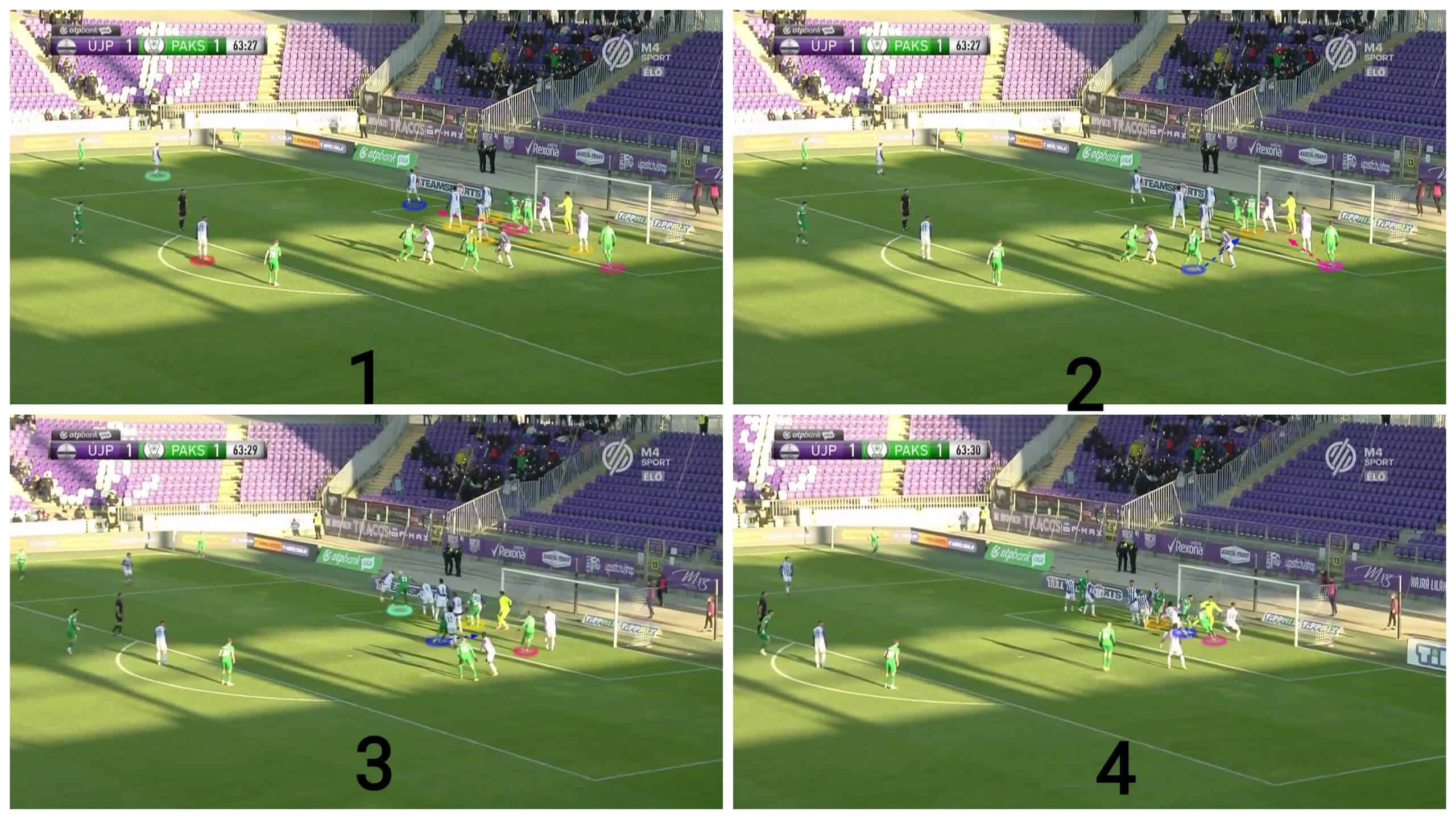
In the case below, we want to show how diverse they are in using flicks, so you can find below two blue attackers targeting the same area, overloading it to increase their possibility of getting the first touch.
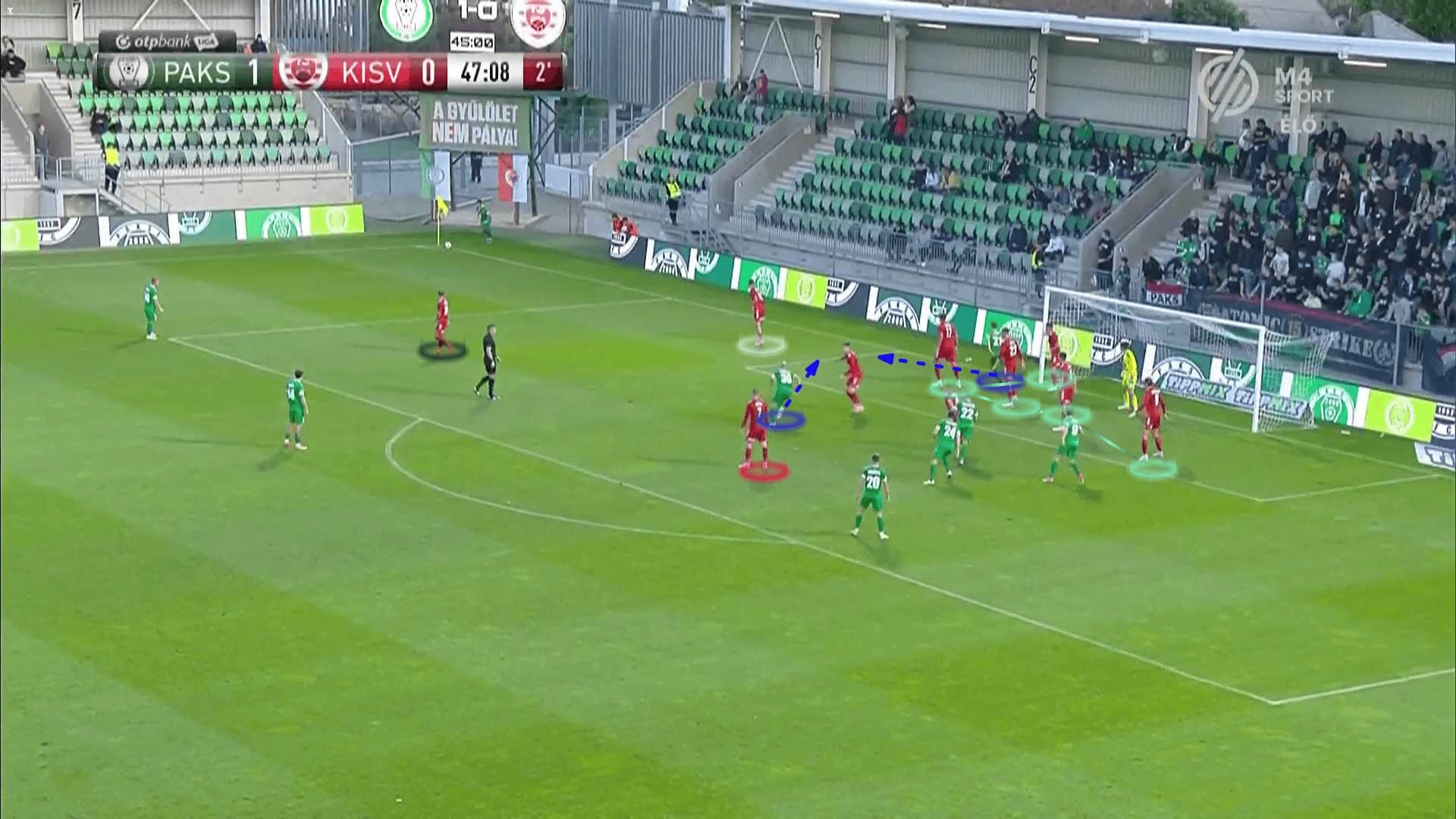
In the photo below, you can note that the final destination is the same: getting the first touch and framing the goal by the three highlighted players.
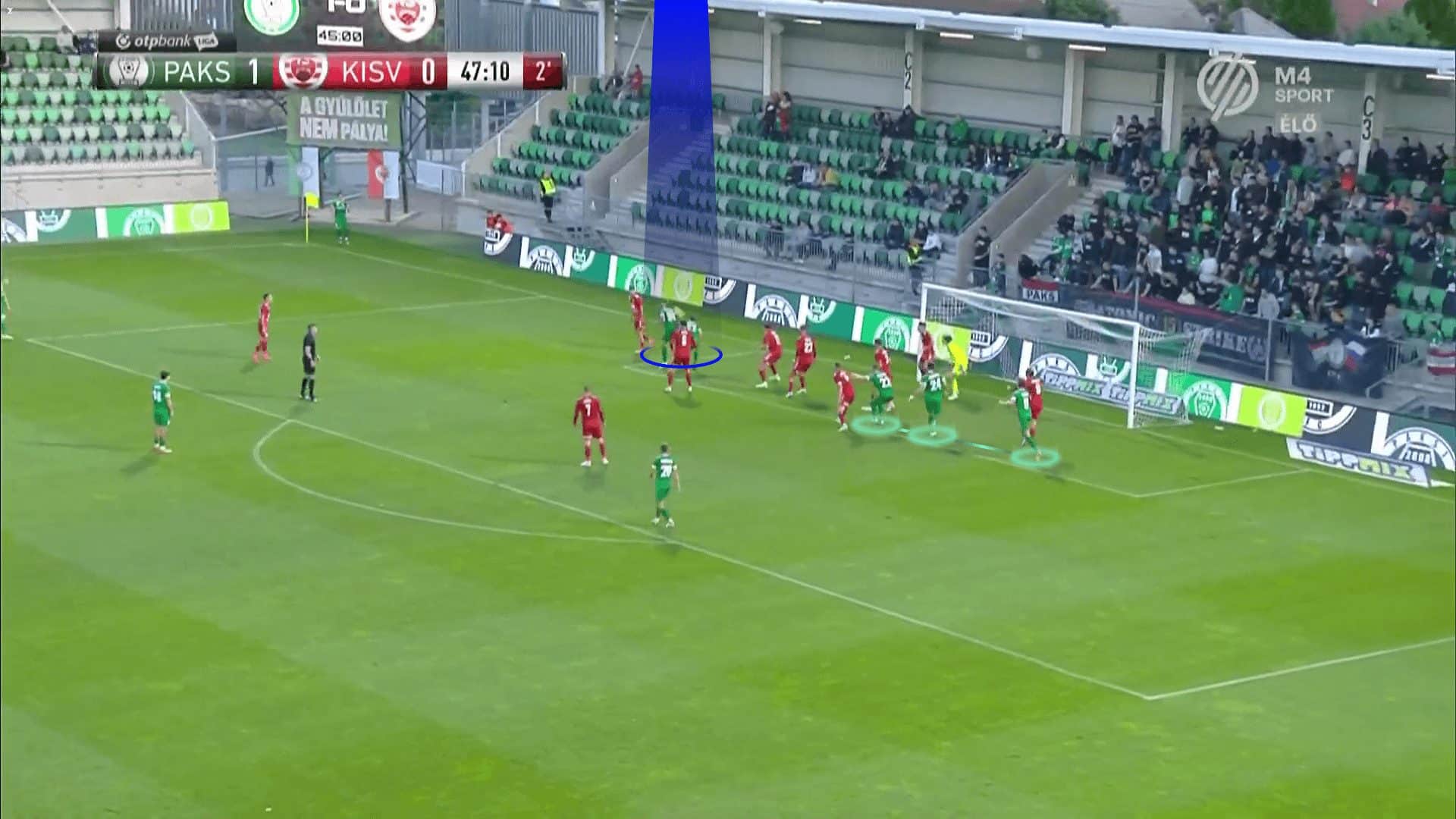
But they couldn’t flick the ball well, so it hit the defenders.
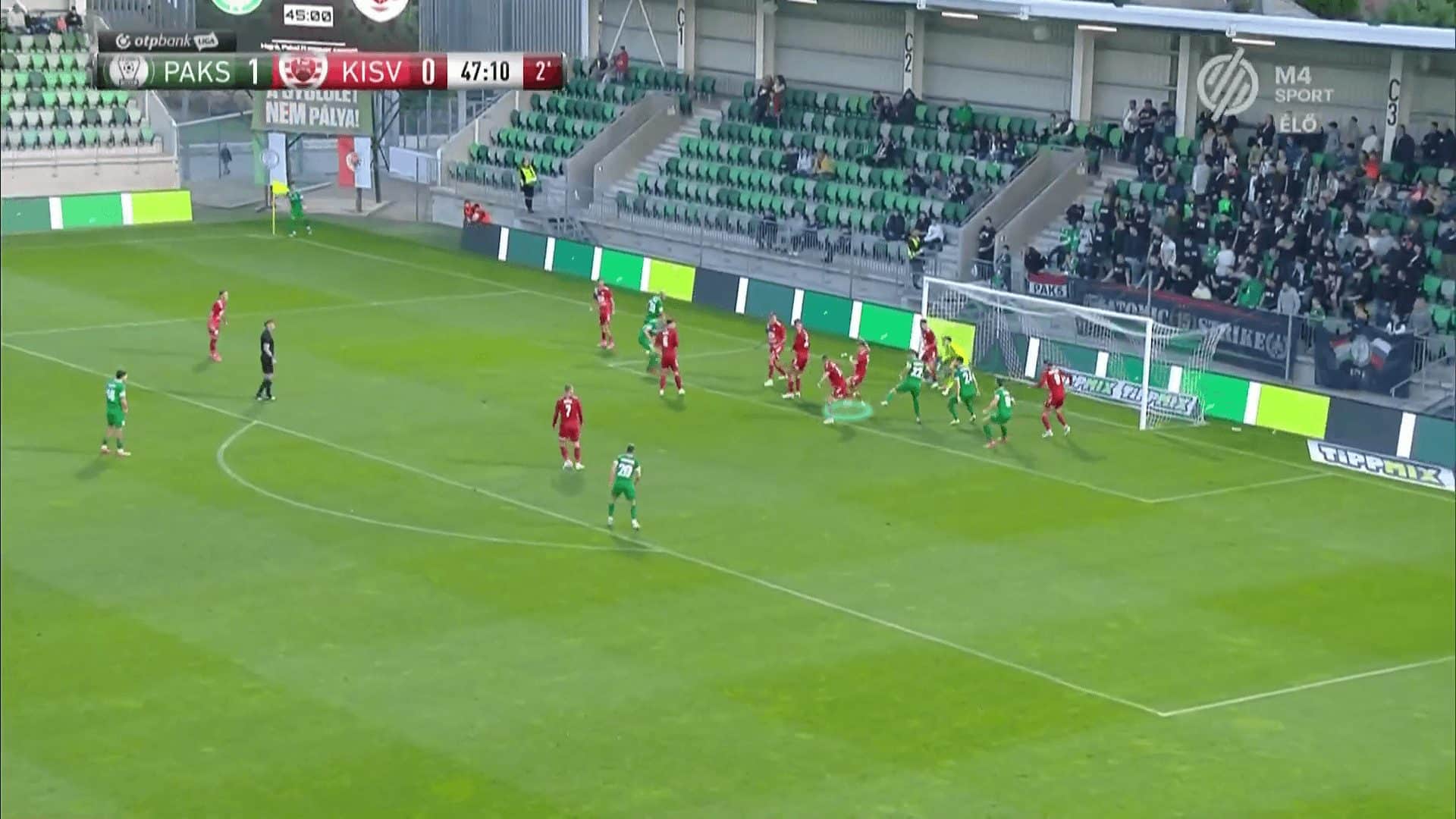
Going back to the same case after summarising their intentions, we want to get into the details deeply. At first, the defender responsible for defending flicks was dragged, worried about the short corner because Paksi FC overloaded this area, the short and rebound area, with four green players against two defenders achieving numerical superiority in case of the short option. When he got sure that the ball wouldn’t be passed shortly, he started to step back, but he was late.
The other thing we want to discuss is the attackers’ initial positions inside the six-yard dragging their markers with them and then going back, as shown below.
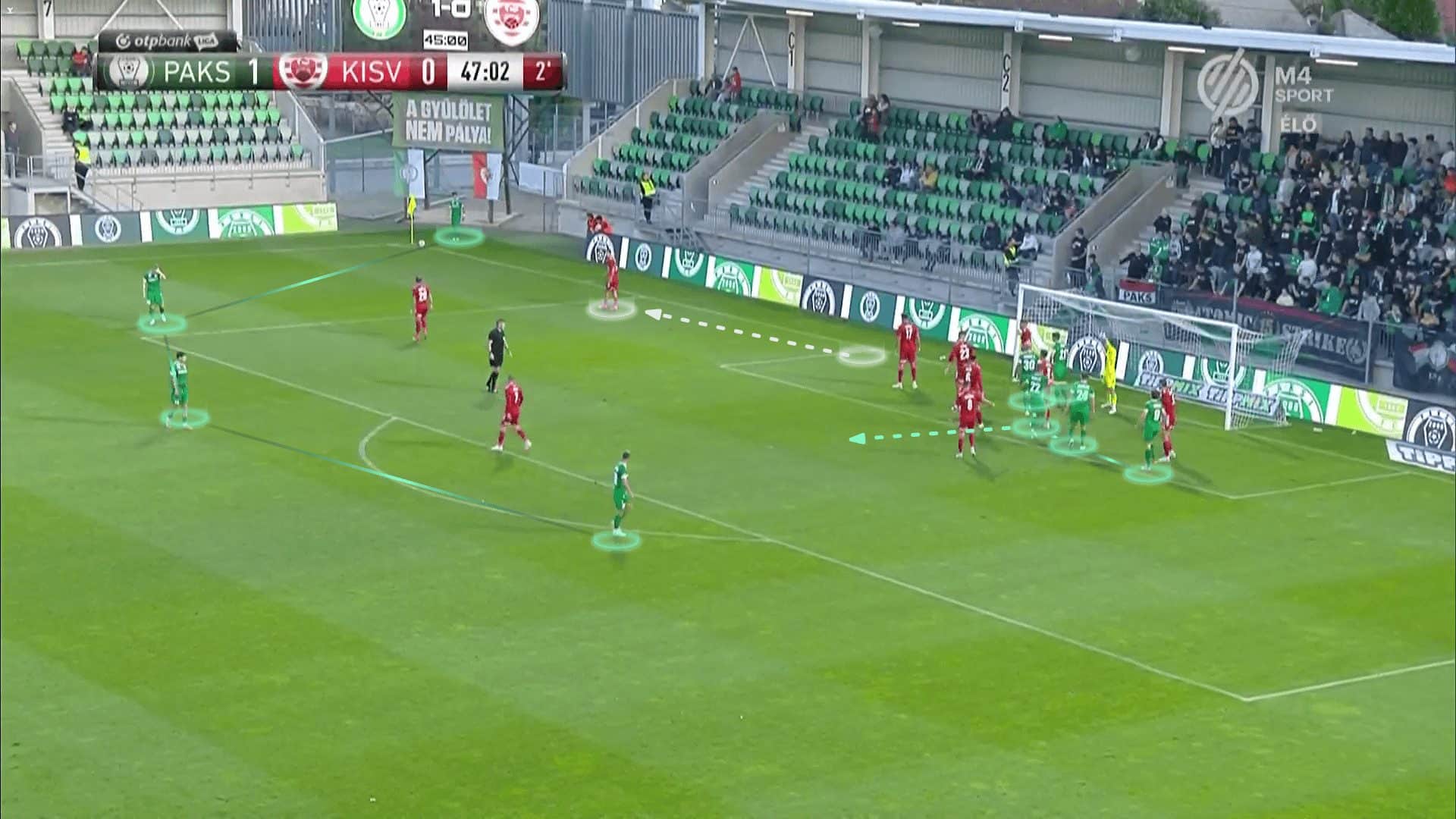
This sudden movement to the back gives them space far away from their markers’ physical contact, which makes the green highlighted player go to the targeted zone with all of his momentum without the annoyance of his marker.
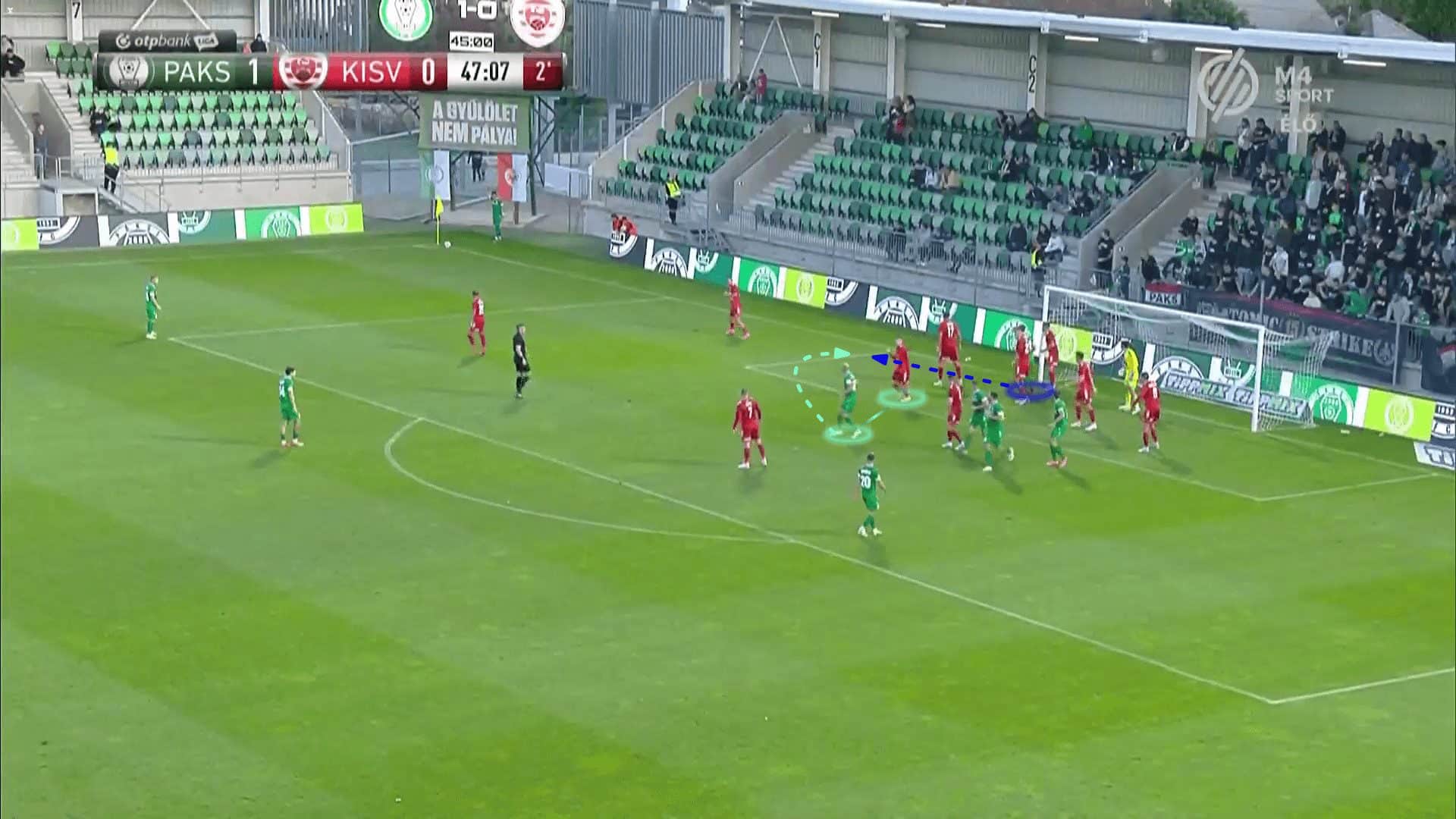
This curved movement to the back and then to the front again makes it difficult for the marker to track the ball and the attacker simultaneously, making it easy for the attacker to frame the goal, waiting for the headed pass, as shown below.
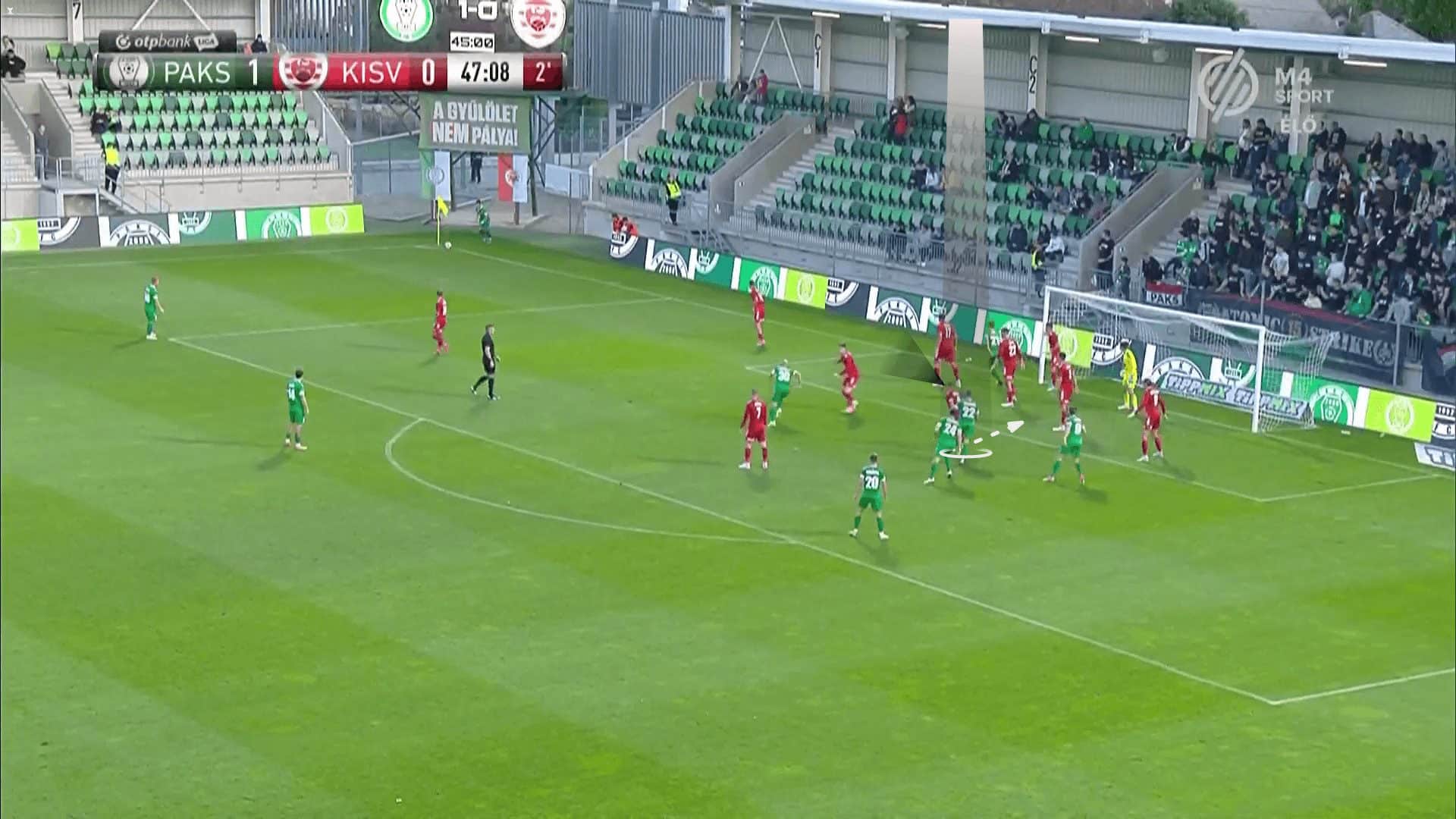
As we have mentioned above, they are diverse in using flicks, so we see below another way of their flick routines: making the six-yard crowded with all of their attackers. Then, the targeted player suddenly moves from the defender’s back to the targeted area, making it difficult for the defender to measure the ball in the air and track the attacker at his back simultaneously.
The other benefit of this traffic inside the six-yard is framing the goal and having a player blocking the goalkeeper, preventing him from getting the ball, but this time, the attacking team also affects the vision of the goalkeeper and his ability to move well. Besides that, when the headed pass landed, the chaos that happened was beneficial for the attacking team, and let’s call it the contrived chaos.
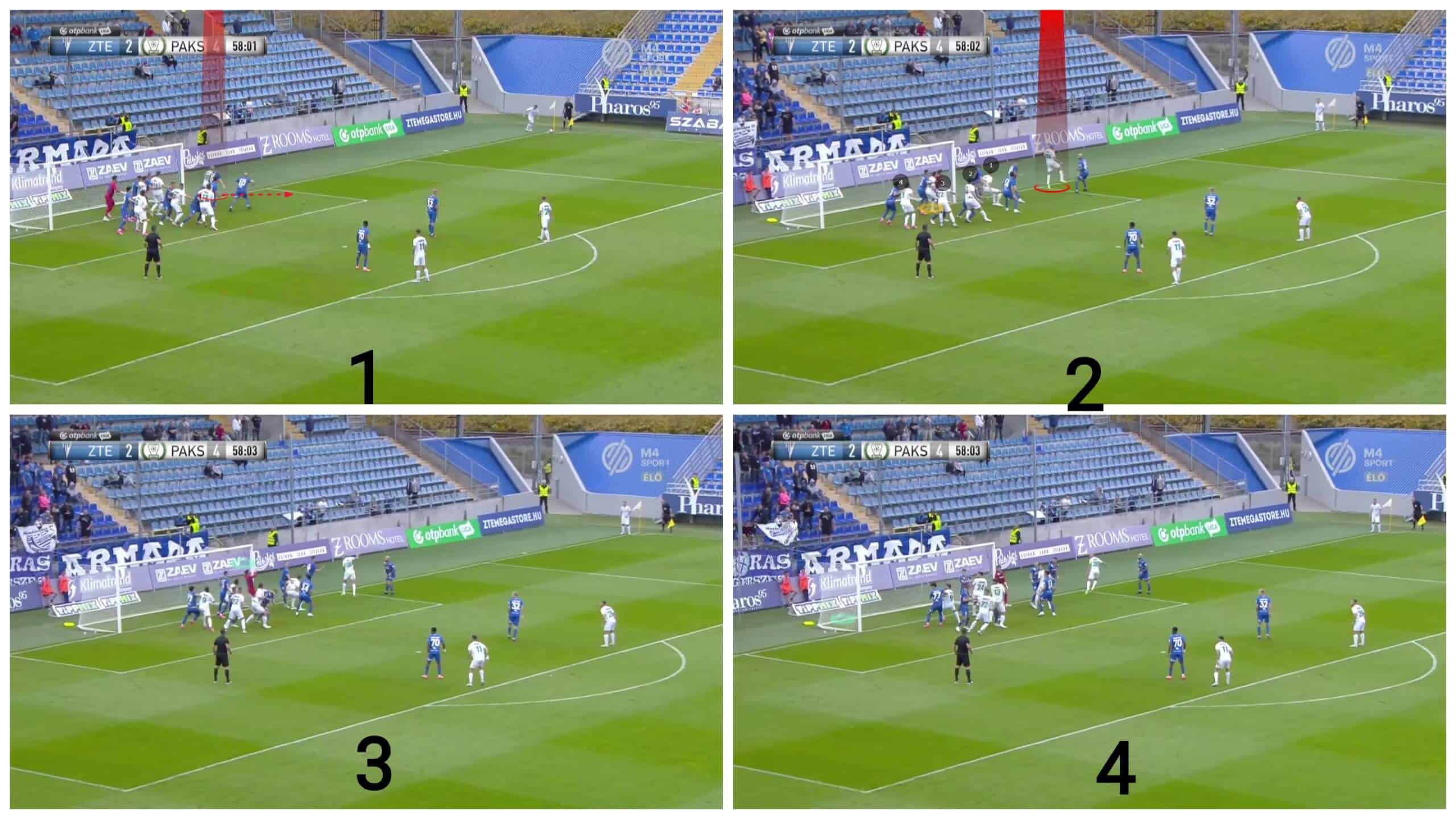
Fake flicks
They also have an excellent deceiving idea: using a fake-flick run, which means that a player moves at first pretending that he would flick the ball to drag defenders and then, another attacker targets the space left.
In the first photo below, the defending team is defended by a man-marking defending system with only two zonal players in green. The yellow-arrowed player runs, pretending that he will flick the ball while the red-highlighted player exploits the area before him with the help of his mate, who blocks his marker, a screen in pink. Another benefit of the yellow player who has left the six-yard is that it is now empty for the three players who go to frame the goal, as shown in the second photo.
The plan works, and a player from the three gets the ball, scoring a goal, as shown in the third and fourth photos.
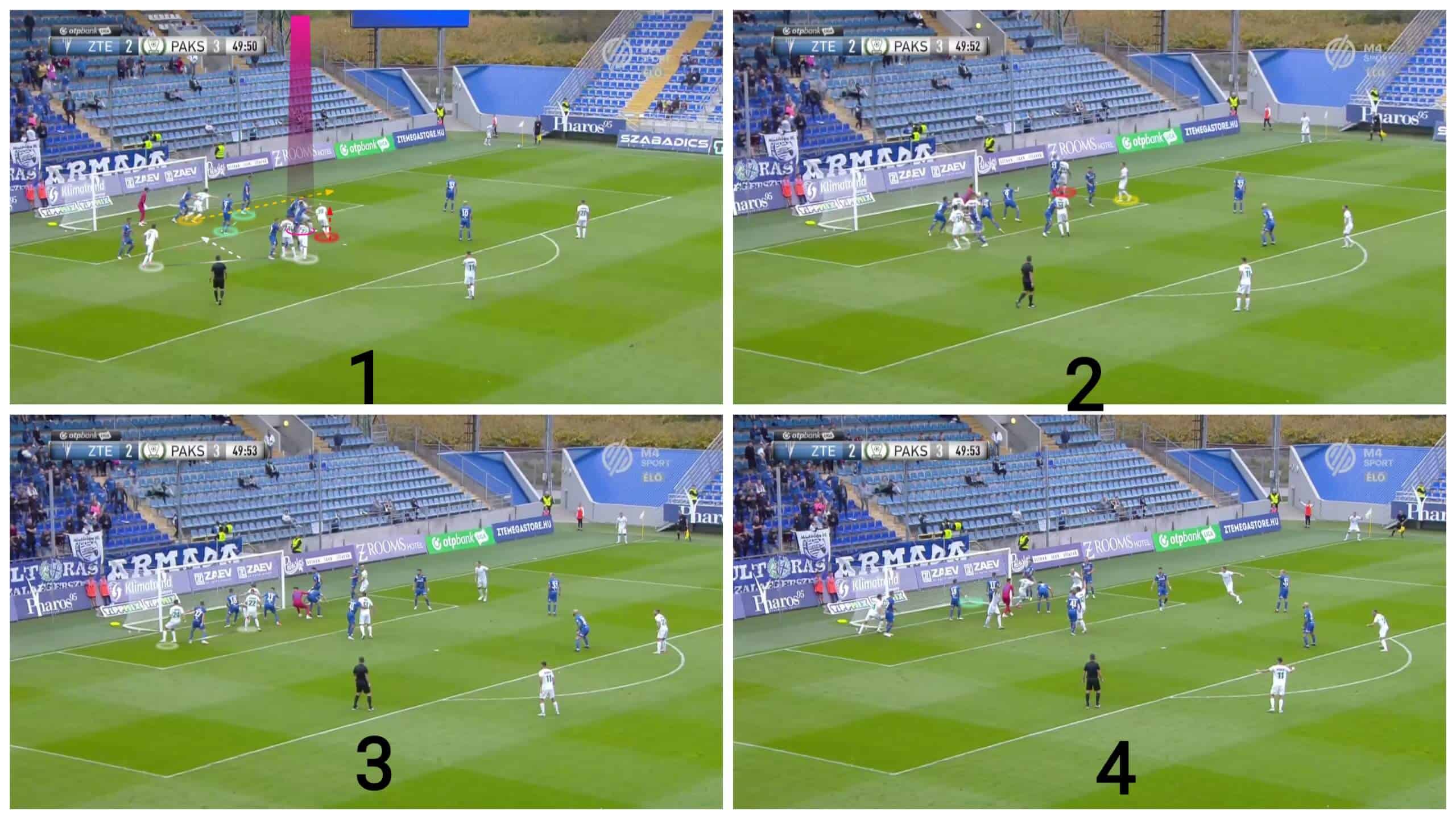
Overloading the far post
As a variation, they also target the far post, sometimes exploiting the opponent’s care about the near post, so in the first photo below, the defending team defends with five zonal players, two man markers and three players at the short area because Paksi FC’s usual overload of this area to drag the flick defender.
The blue attacker runs towards the flick area while the pink attacker runs behind him, as in the case above, but for another purpose. The other two attackers join their teammate on the far post to overload it against only one defender to win the first touch, as in the second photo where the pink player’s role now is free to get the headed pass again on the near post exploiting the defenders’ attention to the ball in case they can’t score it directly on the far post.
In the third photo, the plan works, so the player gets the ball easily scoring a goal, as in the fourth photo.

As we have just mentioned, the far post, attackers may try to score the goal directly if it is possible, as in the case below where the opponent defends with four defenders at the first zonal line, three are close to each other on the near post leaving one alone on the far post. They have also a flick defender, another zonal player on the penalty spot, a short-option defender, a rebound defender and two man markers.
The plan depends on an important principle: misdirection by the movements of all players to the near post, dragging their man markers, leaving only two players against one defender on the far post. One was initially standing in the targeted zone and the other started in the six-yard and then stepped back while the movements of his mates to the near post not to take the attention of the defenders, as shown below.
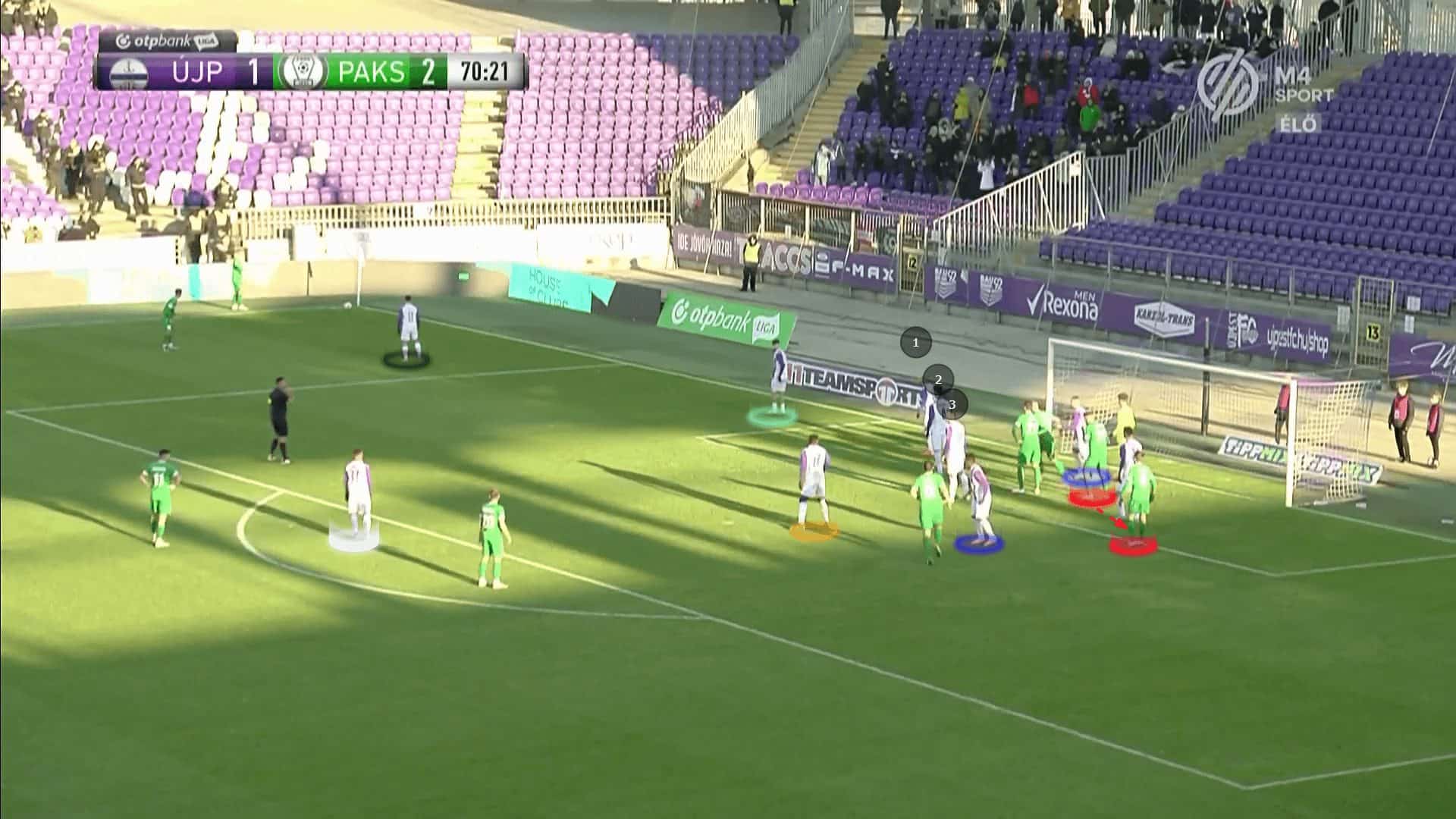
The plan to overload the far post works, but the ball hits the crossbar, as shown below.
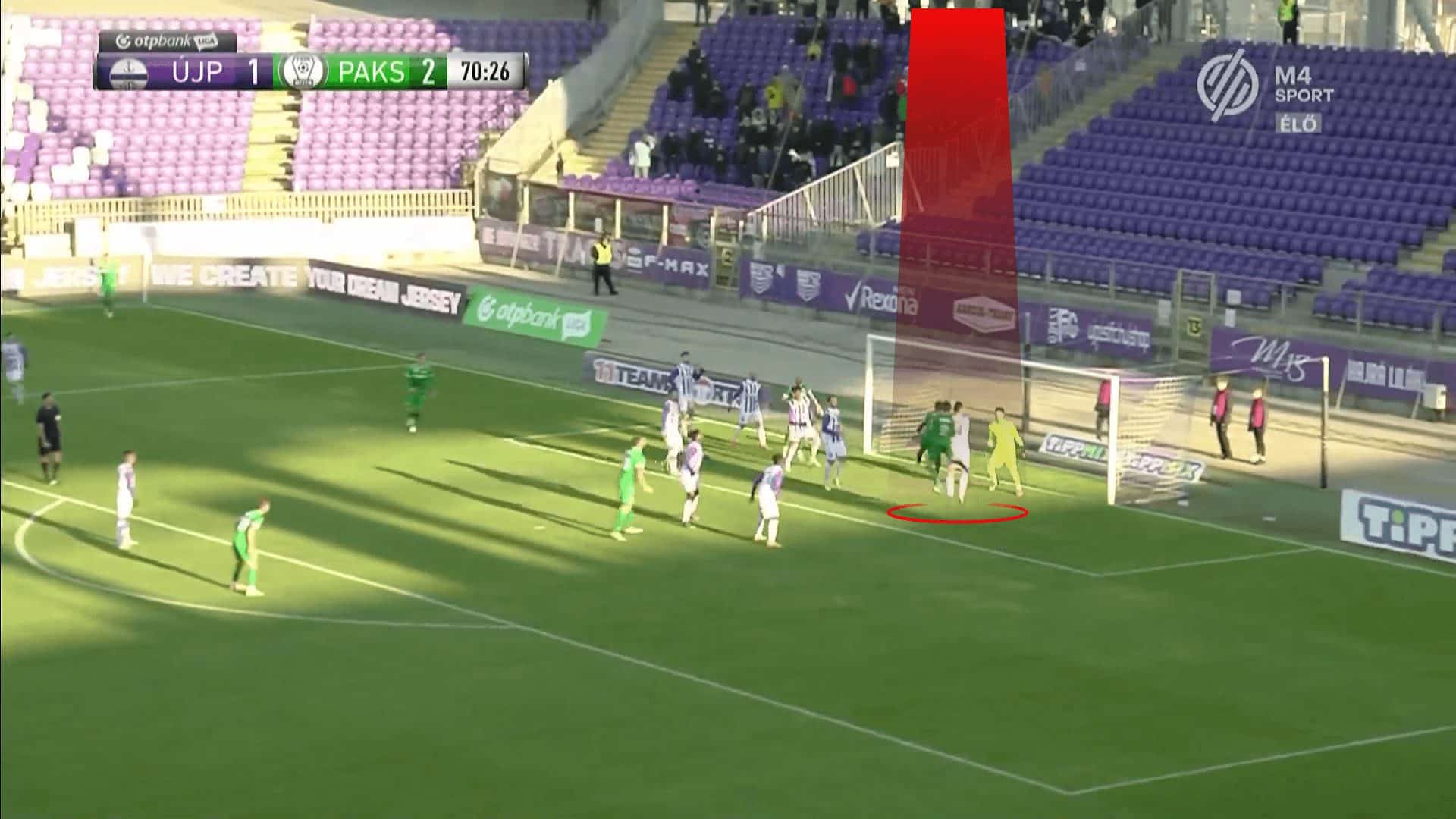
Conclusion
In this analysis, we have explained how Paksi FC has exploited their attacking corners and how they became the team to score goals from corners in the league until this moment, with 11 goals under the leadership of their coach, Bognár György.
In this set-piece analysis, we have shown how they are simply exploiting offensive corners with many ideas like using flicks with many different routines, fake flicks, and overloading the far post.

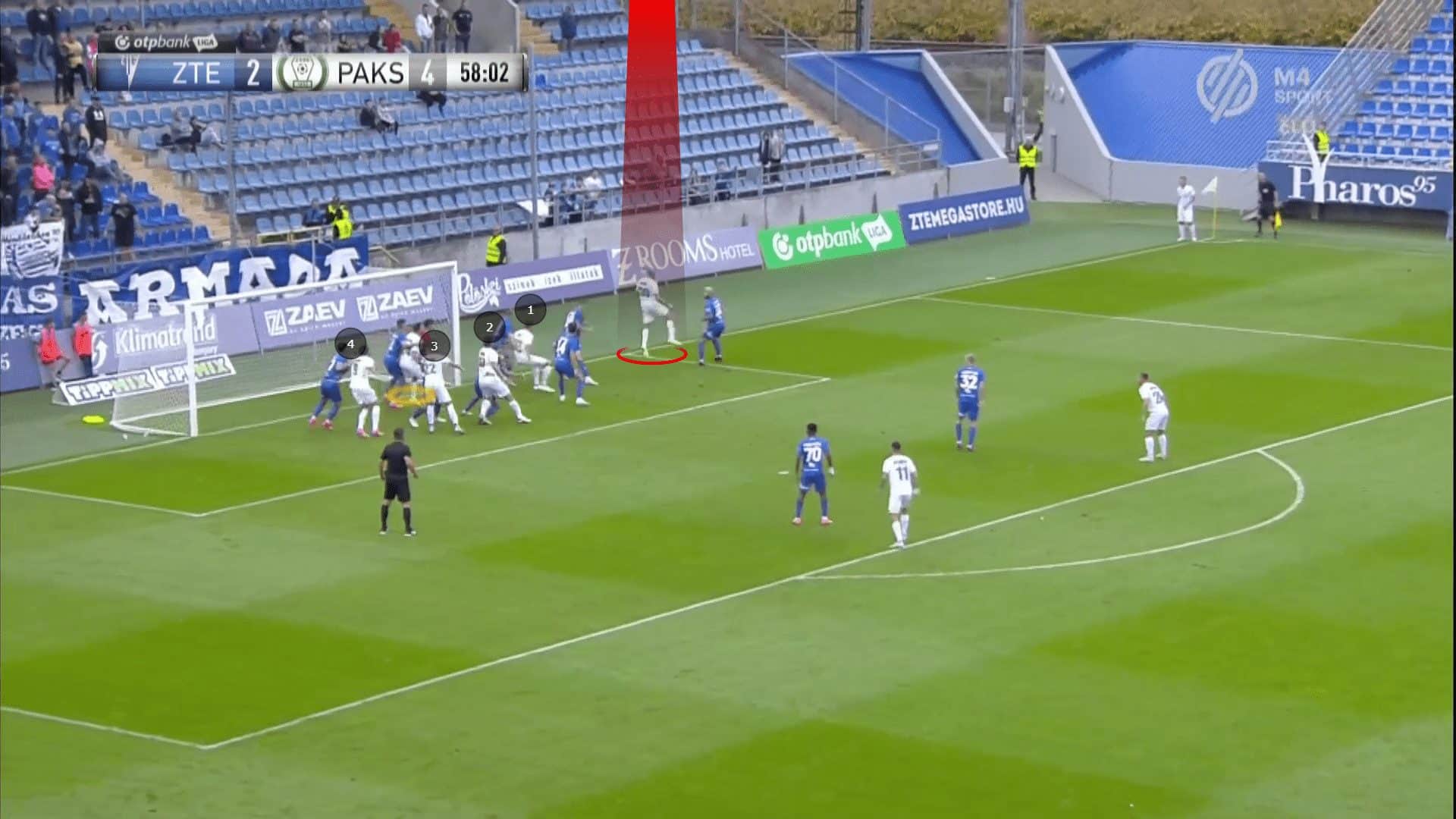




Comments